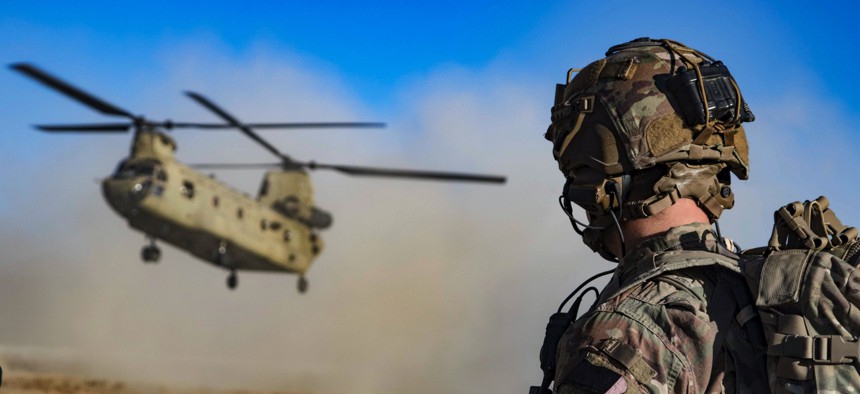
Army Staff Sgt. Jason N. Bobo watches as a CH-47 Chinook prepares to land to provide transport for U.S. and Afghan soldiers after a key leader engagement in southeastern Afghanistan, Dec. 29, 2019. Army Master Sgt. Alejandro Licea
US Agrees to Reduce Forces in Afghanistan ‘If Taliban Live up To Their Commitments’
The tests will begin with a seven-day ceasefire to start “very soon,” a senior U.S. administration official told reporters.
MUNICH – The United States and the Taliban have reached an agreement for a seven-day ceasefire that will start “very soon,” a senior administration official revealed on Friday, adding that that the U.S. has agreed to reduce its military presence in the country “if the Taliban live up to their commitments.”
U.S. Secretary of State Mike Pompeo and Defense Secretary Mark Esper met with Afghan President Ashraf Ghani at the Munich Security Conference on Friday, along with Amb. Zalmay Khalizad, lead negotiator of the agreement, and Gen. Scott Miller.
“The reduction-of-violence agreement is very specific,” the senior administration official, who was not authorized to speak on the record, told reporters at the Munich Security Conference. “It includes everything — roadside bombs, suicide bombs, rocket attacks – that’s all written out.”
It will be up to Gen. Scott Miller — the senior U.S. military commander in Afghanistan — to determine whether the Taliban is breaking the ceasefire, or whether such violence should derail the peace process.
The official said there is a channel between the U.S. military command and the Taliban “to monitor, discuss, and raise issues…We have a lot of means for monitoring the situation in Afghanistan, so all of them will be engaged.”
The official likened the agreement to Cold War nuclear arms agreements with the Soviet Union.
“We don’t trust, but we will have to verify,” the official said. “There will be monitoring, there will be verification associated with it and see if the Talib deliver. If the Taliban live up to their commitments, we have commitments in terms of reductions of forces, which are also specific and time-lined.”
Those American troop withdrawals would be based on conditions and come in phases, the official said.
The official outlined the peace path the Trump administration wants. If an actual reduction of violence occurs and holds, the next step is inter-Afghan negotiations with the government, which already has agreed to those talks.
“That’s in black and white in the agreement,” the official revealed.
Trump administration officials hope this will lead to a more “comprehensive and permanent ceasefire that ends the Afghan-Afghan war.”
Why now? The U.S. official said there was nothing on the Taliban side that changed their minds. This was all the work of the U.S. president, the official insisted.
“I think the credit really goes to the president – President Trump,” the official said.
Trump suspended negotiations and called them “dead,” after September’s rise in violence.
“The Talib want the agreement. It’s a big change that they’ve agreed to break with terrorism and [that] under the areas that they control there will be no hosting, no presence, no training, no recruitment, no fundraising by terrorists who threaten the United States or our allies,” the official said.
